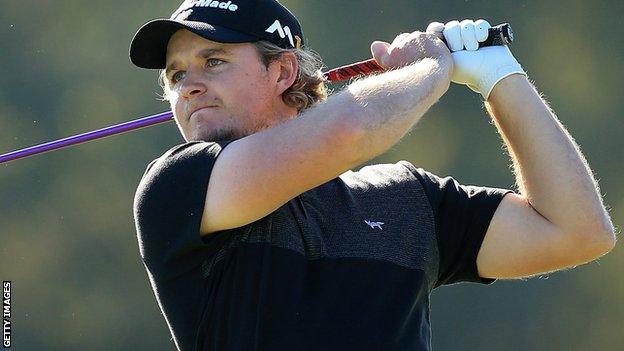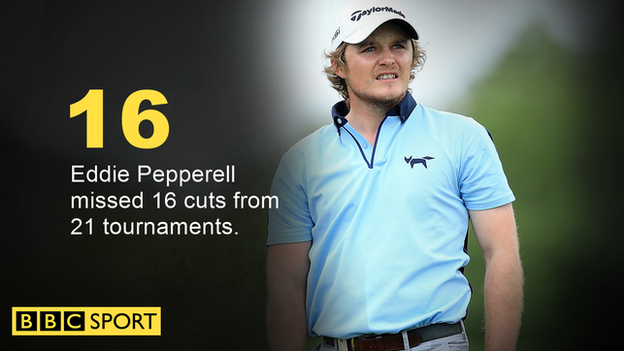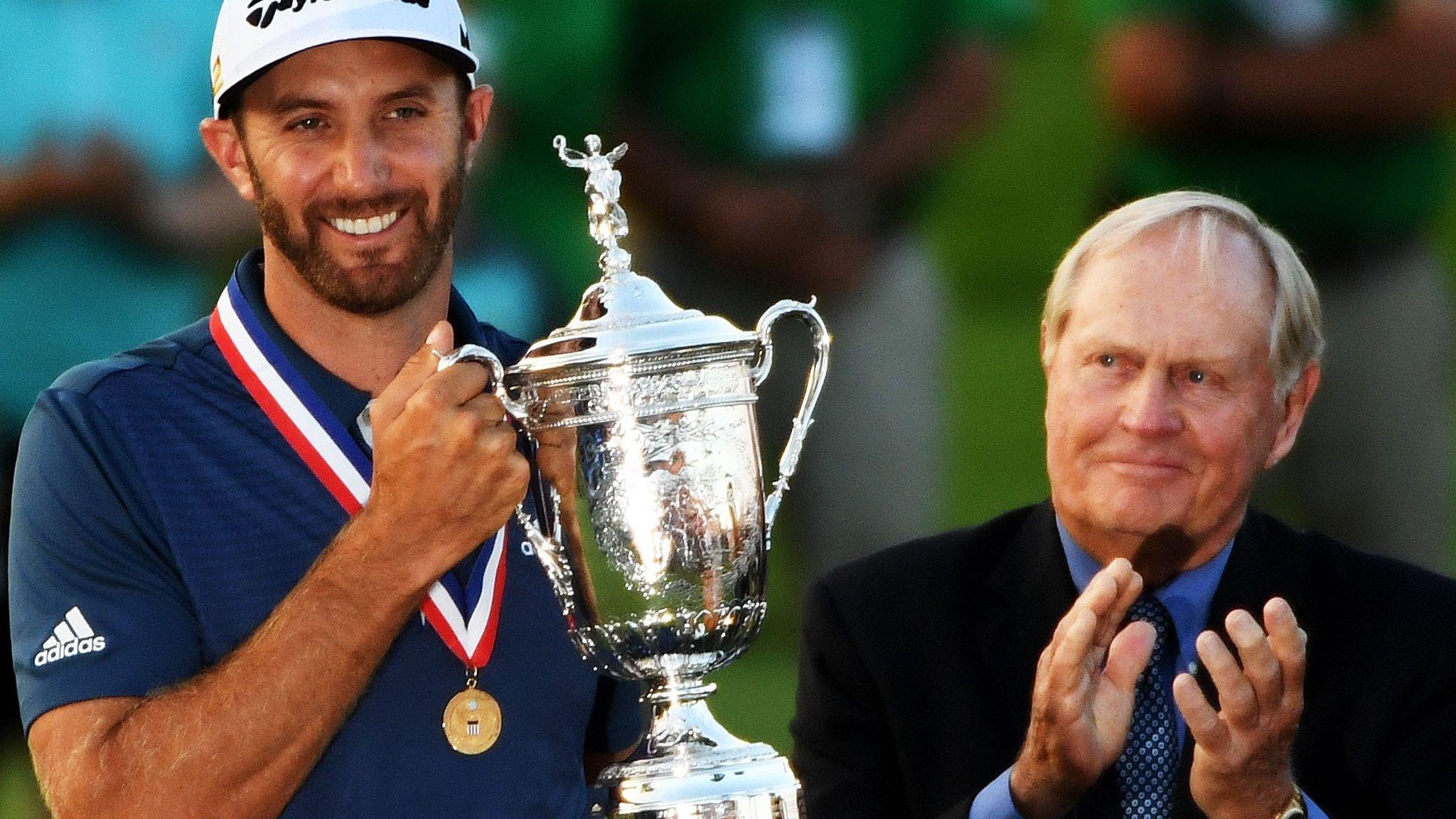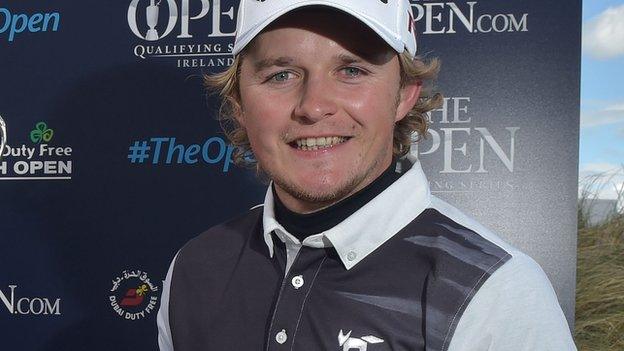US Open 2017: Eddie Pepperell's journey from Tour School to Erin Hills
- Published
- comments

Eddie Pepperell is one of 15 players who qualified from a 36-hole tournament at Walton Heath
US Open, Erin Hills, 15-18 June |
|---|
Coverage: Listen on BBC Radio 5 live and BBC Radio 5 live sports extra. Live text commentary on the BBC Sport website and sport app. |
They call the US Open the most democratic event in sport, with almost 9,000 entrants and only 156 spots in the starting field.
Elite names, such as world number one and defending champion Dustin Johnson, are guaranteed their place, indeed the top 60 in the world are all automatically eligible.
But this is an event that does what it says on the tin. It is "open" to the lower echelons who have earned their chance to rub shoulders with the big boys at Erin Hills this week.
From the 8,979 professional and amateur golfers who teed it up in local qualifying, 525 progressed to be part of the 902 who competed at the sectional stage, which in turn yielded 72 with a golden ticket to the second major of the year.
These include 22-year-old Aaron Rai from Wolverhampton, who won the European sectional tournament at Walton Heath. It was this qualifier that produced the eventual champion, Michael Campbell,, external in 2005.
Scotland's Richie Ramsay, Bradley Dredge of Wales and Englishmen Andrew 'Beef' Johnston, Matt Wallace and Eddie Pepperell were also among the 15 who progressed from the 36-hole tournament.
Of those British qualifiers, Pepperell's is perhaps the most heart-warming story.
The 26-year-old, who was prominent on the 2015 Open leaderboard at St Andrews, is emerging from a torrid spell in which he was forced to return to Tour School to retain his European Tour card.
"The last year has been a bit of a struggle and I lost a lot of confidence," Pepperell told BBC Sport.
After finishing eighth in last year's Irish Open, he missed 16 cuts in 21 tournaments, tumbling from a career-high of 80th in the world to outside the top 500.
"There have been times where I've gone home quite stressed and, yeah, feeling a bit low," said Pepperell.
"And you have some alcohol or whatever just to get away from it, and I've experienced what it's like to live under a bit of stress.
"It's all part and parcel of life and makes the good times all the more enjoyable."
At Walton Heath, Pepperell carded rounds of 67 and 66 to book his place in Wisconsin, before continuing his fine form with a top-10 finish at the Nordea Masters later that week.
"Qualifying for the US Open, having my dad and family there and seeing them smiling, knowing they'll come over to America and have a great time, it was really nice. We are going to enjoy it," he said.

The Oxfordshire pro credits a change of clubs and ball as the main reasons for his return to form.
"Modern equipment is just designed to go further, through a higher launch angle with less spin off the tee and that's never really been my game," Pepperell said.
"I'm a natural, feely kind of player and I've learned that I actually need some backspin on my driver so I know when I'm on the tee and not feeling very comfortable I can tee it down low and squeeze one out there and get it in play."
Anyone who reads Pepperell's regular and honest blogs, external knows the former British amateur international sees more to life than bashing balls and holing putts.
But coping with the demands of the toughest of the majors will be uppermost in his mind this week in what will be his second US Open, having qualified for Merion in 2013.
Erin Hills is a monster that can play anything up to 7,800 yards. It is the first par-72 course to stage America's national championship since Pebble Beach in 1992.
"The way I see it, every tee shot is hard, every approach shot is hard, the whole week is hard," Pepperell said.
"There's just constant pressure, a constant need to hit really good golf shots. In many ways I think it brings the best out of you because you know what you have to do.
"The way you react is the key. You either become afraid or think 'you know what? I've got nothing to lose here'.
"I'm just going to try and make great swings for four days and let's see what happens.
"In my two American majors so far I have putted really poorly, so most of my preparation will be around long-range and short-range putting. You are going to have to hole those six-footers."
This will be the mantra for much of the field, regardless of their background.

Dustin Johnson will be the first player since 1989 to retain the US Open title if he wins at Erin Hills
Johnson's length off the tee and outstanding form since breaking his major duck 12 months ago make him a justifiable favourite.
But defending champions rarely fare well. Tiger Woods (tied sixth in 2009) is the only one to make the top 10 since Curtis Strange retained his title in 1989.
Northern Ireland's Rory McIlroy has played only 72 competitive holes since the Masters following the recurrence of his rib problems and will do well not to be undercooked.
Having said that, he has had plenty of opportunity to work on his short game, which will be such a vital component.
With four par-fives at Erin Hills, the other key areas are driving distance, and approach play from 100 yards and in.
Looking at statistics covering these areas, a shortlist of leading exponents includes Americans Justin Thomas, Rickie Fowler, Jordan Spieth and Brendan Steele, and Spain's Masters winner Sergio Garcia.
McIlroy and Johnson also show up well statistically, and if Jason Day can find his touch on the greens, this looks an ideal test for the Australian, who has yet to fire this season.
But the penal nature of the US Open makes patience an important virtue and this is an undoubted strength of 2013 winner Justin Rose.
As he prepares for his fourth major, Pepperell insists he will not be daunted by the strength in depth at the top of the game.
"I don't really care whether I'm chipping next to Rory McIlroy or my dad to be honest," he said, laughing.
"It's just one of them is better at golf than the other.
"For me it's not the players, it's the crowds, the atmosphere, the hum, the whole environment. It's completely different to what we are used to.
"In Europe I played an event and I was third and there were two people watching and I was thinking, 'well this isn't very inspiring', and this week I could have 2,000 people watching me on the first tee."
The same applies to all those who have earned their crack at a week of genuinely big-time golf - no matter how tortuous their route to get there.
- Published20 June 2016

- Published12 July 2015
